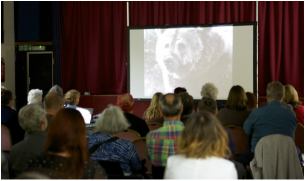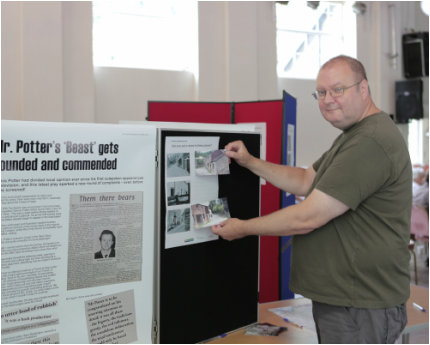
Saturday 18th July was a sunny day in Lydbrook, the long thin village that stretches down either side of a Forest of Dean valley and terminating at the banks of the River Wye. At the height of the mid-afternoon sunshine over 50 local people were sat in darkness, the only light provided by the projector showing a black and white play from nearly 40 years ago. They were watching A Beast With Two Backs, Dennis Potter's BBC Wednesday Play from 1968 - a play filmed almost entirely on location in and around Lydbrook. Amongst the audience were people who remembered it being filmed, watching it on TV, and some who as school children had taken part.
The screening formed the highlight of a day-long exhibition about the play's production, controversy and critical reception, as well as the notorious real-life local event that was Potter's inspiration for the plot. There were a series of talks and discussions led by longtime Potter-studies collaborators Jo Garde-Hansen of University Warwick, Jason Griffiths and Hannah Grist of University Gloucestershire. There were some insightful interventions from Phillippa Turner archivist in charge of the Dennis Potter archive & exhibition at the local Dean Heritage Centre, at one point clarifying the level of detail in Potter's script (having the original manuscript there for all to see). Discussions ranged from if and how Potter should be commemorated locally (a blue plaque?), to what the play tells us about trolling on social media today.
As well as Potter enthusiasts from far and wide, organisers were very pleased to also be in the company of Australian born actor Rosalie Horner who played the barmaid in the play. Now a successful film & television journalist Rosalie travelled to the Forest especially for the event.
The event brought new detail to the history of the production, aided by the remarkable archive of Lydbrook Historical Society's Lyn Walker that included photographs of the child extras of Lydbrook School pictured in full Victorian costume.
Not only were names put to faces, local residents also helped to identify exactly where scenes were filmed. This included local resident Paul Hayler (pictured) who even replicated the camera angle to compare how his house now had stood in then for the mocked-up pub exterior. Although dozens of interviews were completed on the day there are still lots of new leads to be followed up in the coming weeks.
The engagement in this event shows that Potter's work - especially 'Potter in Place' - continues to generate an enthusiastic and often impassioned following.
The screening formed the highlight of a day-long exhibition about the play's production, controversy and critical reception, as well as the notorious real-life local event that was Potter's inspiration for the plot. There were a series of talks and discussions led by longtime Potter-studies collaborators Jo Garde-Hansen of University Warwick, Jason Griffiths and Hannah Grist of University Gloucestershire. There were some insightful interventions from Phillippa Turner archivist in charge of the Dennis Potter archive & exhibition at the local Dean Heritage Centre, at one point clarifying the level of detail in Potter's script (having the original manuscript there for all to see). Discussions ranged from if and how Potter should be commemorated locally (a blue plaque?), to what the play tells us about trolling on social media today.
As well as Potter enthusiasts from far and wide, organisers were very pleased to also be in the company of Australian born actor Rosalie Horner who played the barmaid in the play. Now a successful film & television journalist Rosalie travelled to the Forest especially for the event.
The event brought new detail to the history of the production, aided by the remarkable archive of Lydbrook Historical Society's Lyn Walker that included photographs of the child extras of Lydbrook School pictured in full Victorian costume.
Not only were names put to faces, local residents also helped to identify exactly where scenes were filmed. This included local resident Paul Hayler (pictured) who even replicated the camera angle to compare how his house now had stood in then for the mocked-up pub exterior. Although dozens of interviews were completed on the day there are still lots of new leads to be followed up in the coming weeks.
The engagement in this event shows that Potter's work - especially 'Potter in Place' - continues to generate an enthusiastic and often impassioned following.

